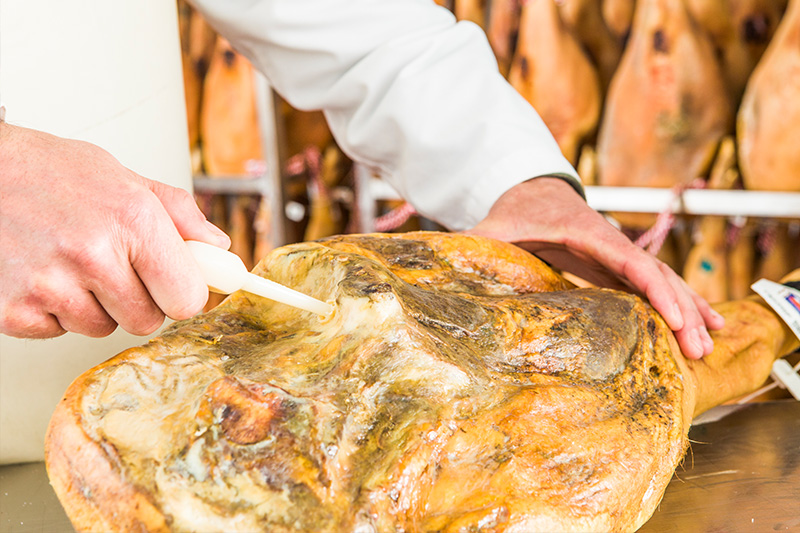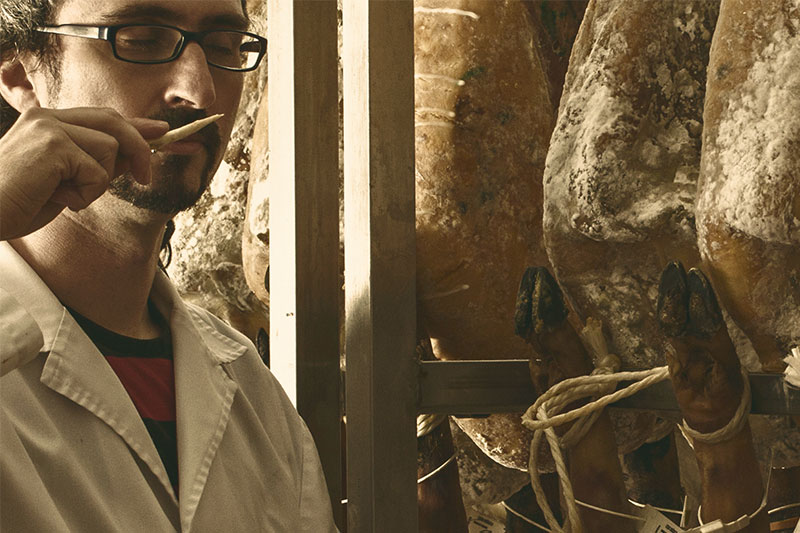
To quote our good friend Clemente Gómez, President of AGACUJ, “a 10/10 ham is a miracle”. Because finding a ham that meets all our expectations without the tiniest fault is not easy. Even more so when this 10/10 is subject to the saying that “there’s no accounting for taste”. The quantity of fat or salt in a ham might be correct for some palates and not for others. Even the topic we want to look at today is susceptible to personal appreciations, as what might be a juicy ham for some is not very well cured for others and what for some is a ripe ham, others find too dry.
Depending on the type of ham that we are talking about, the quality of the raw material we are working from, and the type of processing that we perform, this requires a minimum curing time so that we can talk about ham and not just salted meat. The final goal is simply to dehydrate the piece to preserve it although, depending on how this is done, we will get a final product with varying degrees of quality.
Beyond personal appreciations, there is one aspect that might be used to define a well-cured ham.
Uniform curing
If there is one target parameter when evaluating ham curing, it is the uniformity of its curing. As we have already mentioned at some point, a leg is made up of a series of muscles that respond differently to the passing of time and dehydration. The ham’s inner zones dry out more slowly than the muscles on the outside. The water has to move a greater distance, and this means that it is not easy to get the right texture in these zones without the outer part drying out too much. If this process is not developed correctly, there will be a clear curing difference between the ham’s inner and outer zones. This phenomenon, that makes slicing difficult and affects the quality of the piece, is known as encrusting.
So….how do you know when a ham is properly cured?
When a ham reaches its sales point, it has already passed through the filter that allows it to leave the drying spot. In our case, each piece that leaves our facilities has been selected according to the taste of each professional buying it who, in turn, is aware of the demands of their end customer. We like to say that we know each of our hams by name, meaning that we choose the type of ham (by weight, curing or quantity of fat) to suit the person requesting it. To do this, we select the pieces one by one, assessing their degree of curing manually. The usual way of evaluating a ham’s curing, as well as by its processing time (that depends on the type of raw material) or its morphology, consists of pressing different zones with your fingers and checking the hardness or juiciness. Our experience in this work, along with help from a ‘cala’, gives us a rough idea of each ham’s degree of curing.

We recommend trusting specialised shops. When you find a place that you trust and that also sells the type of ham you like, it’s bound to be a success. In any case, don’t forget that, as we usually say in the sector, “hams are not screws”. As it is a “living” product, coming from an animal and barely handled, we might say that no two hams are the same. But a shop or a trusted brand will help you enjoy the type of ham that you love.



I purchased the special ham at checkers,. and find it salty I
Hi Richard
Nice to know your experience. I would like to know which kind of ham did you purchase. Did you buy Spanish Serrano Ham? There is a huge variety of hams in Spain, even if they are Serrano, Ibérico or another Cualified Quality. And there is a really huge variety of producers. Any of us have our own way to produce, so you can find a lot of different hams in Spain with different quantities of salt in them. Salt is the principal ingredient of ham, but you can use it in different amounts. The more salt you add, the less time you need to make ham. Salt is the ingredient that makes ham progress to be cured and the process can be really long if you don´t like to add a lot of salt, just like we do. I would like you could give Spanish ham another chance, so I recomend you to look at the nutritional facts next time you buy some ham and look for a product that doesn´t have more than 5% of salt. If you can buy ham with less salt and a little of fat, I garantee you´ll have a great ham experience.
Regards